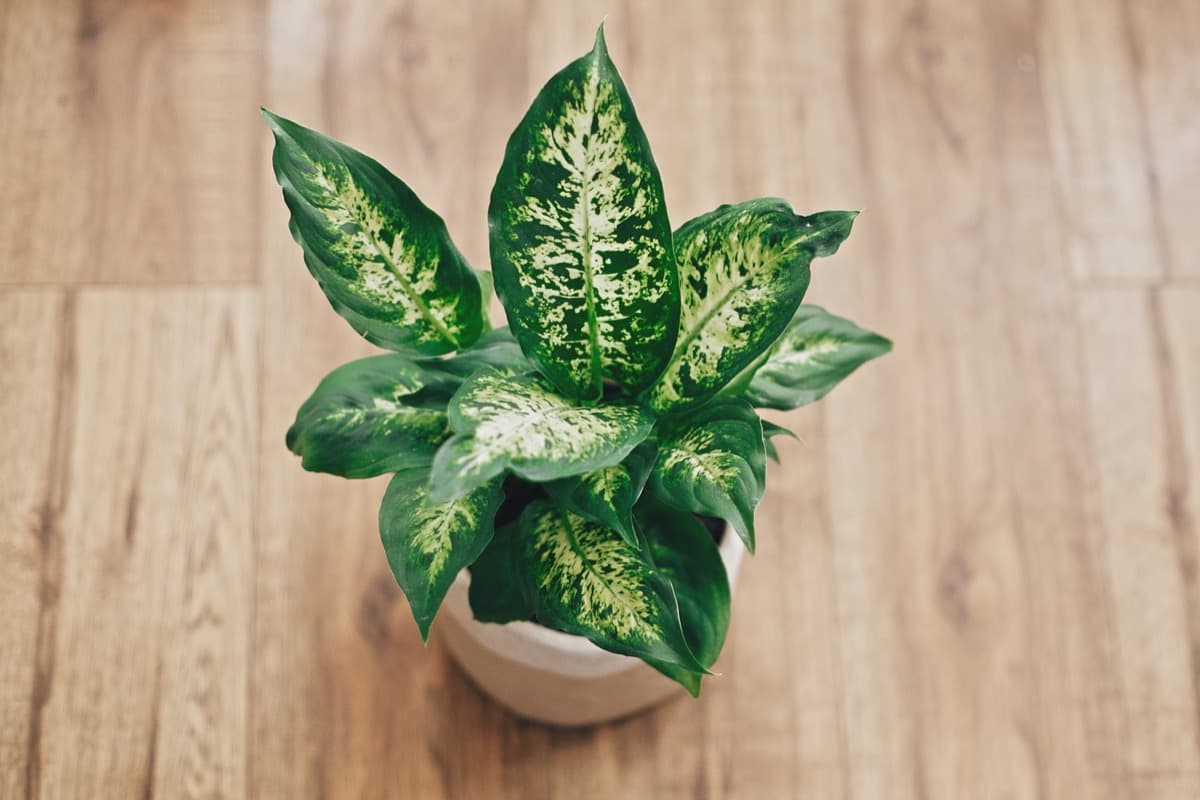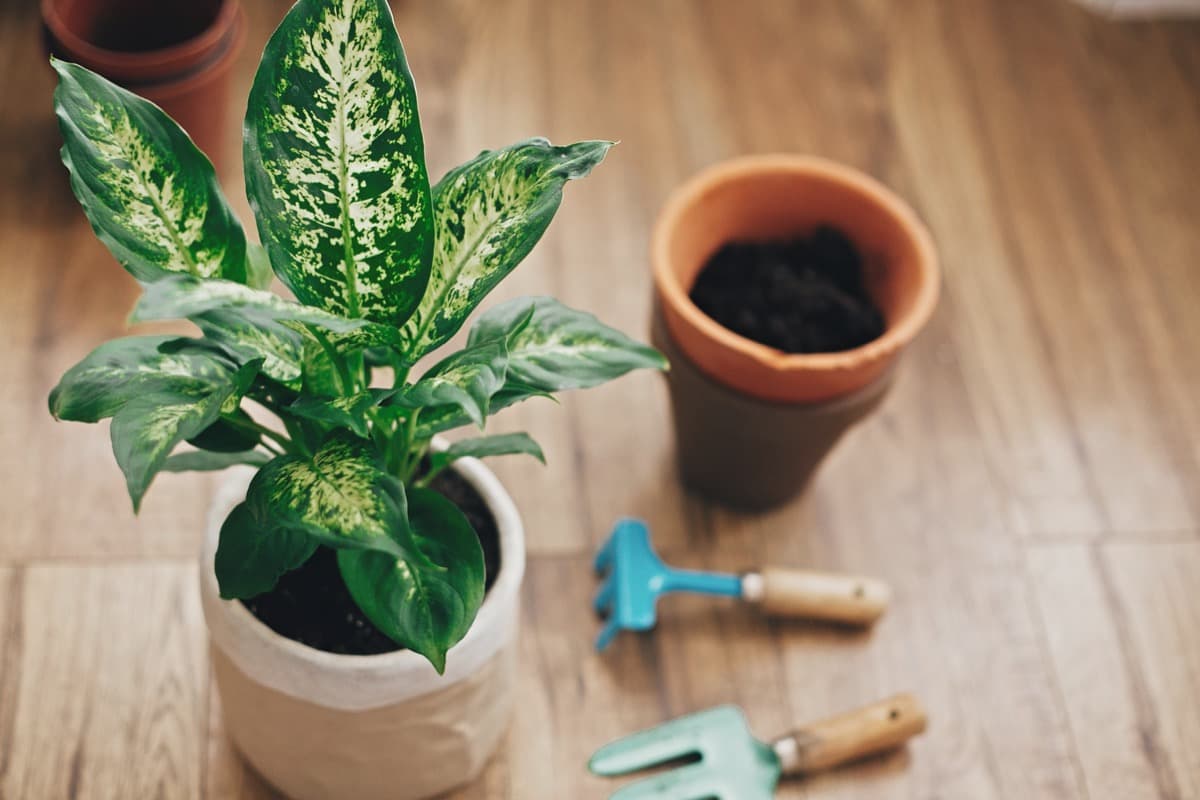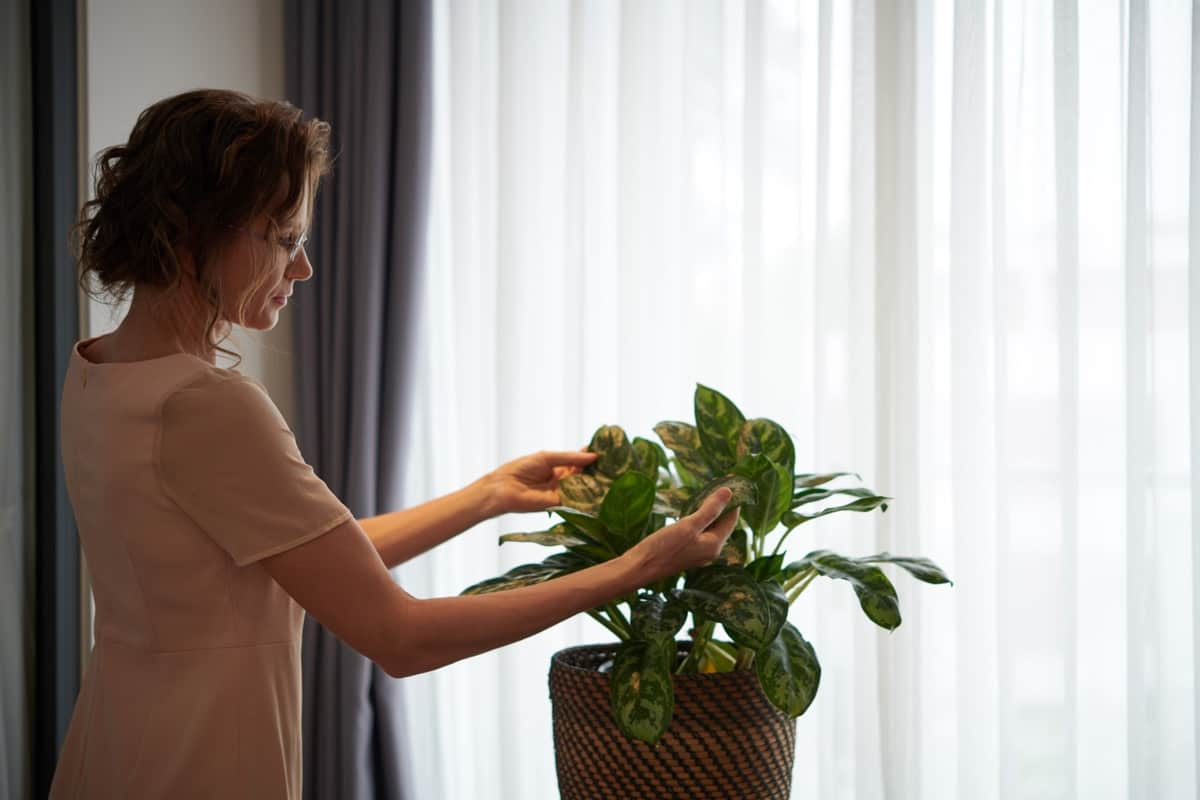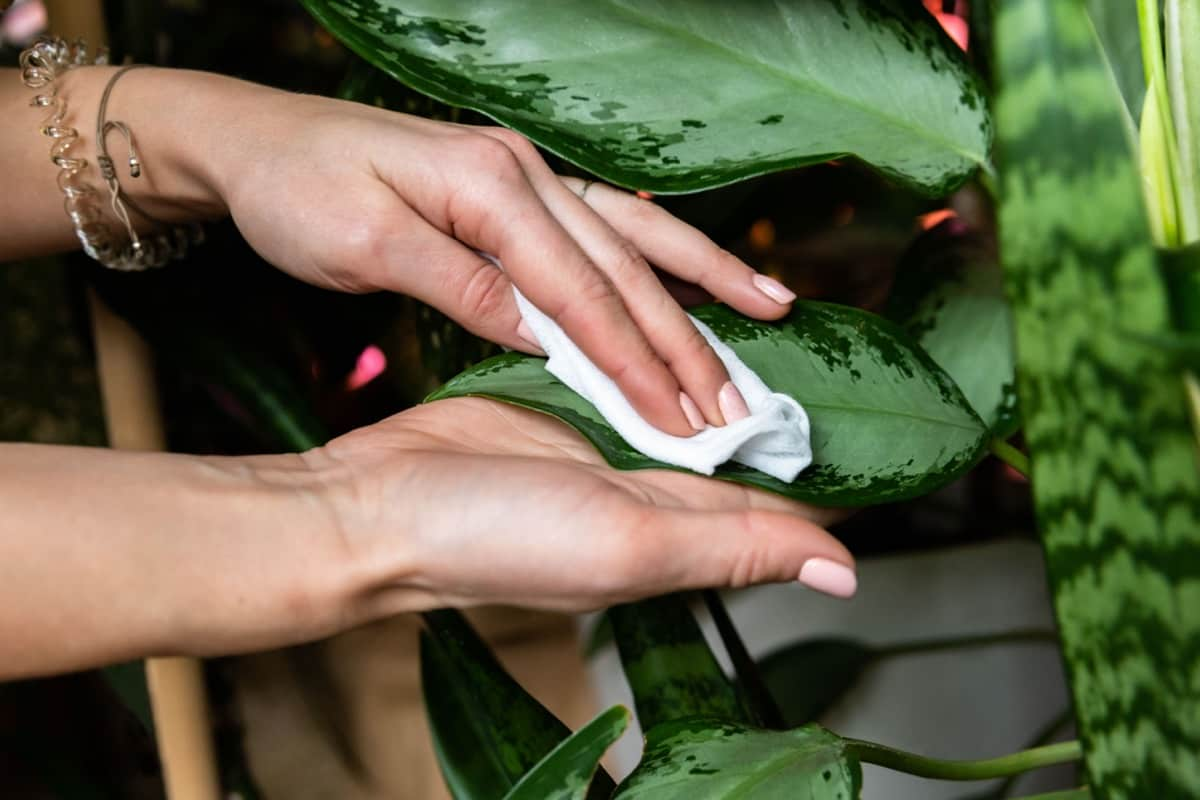Dieffenbachia, or Dumb Cane, is a popular houseplant because it is easy to care for and can tolerate low-light conditions. Dieffenbachia can grow several feet tall and has large, glossy leaves. The leaves are often variegated with white or yellow markings. There are many different types of Dieffenbachia plants, each with unique features and benefits. When choosing a Dieffenbachia plant for your home, it is important to consider its size, growing habits, and light requirements.

Some Dieffenbachia plants are more tolerant of low light than others, so be sure to research the specific plant species you are interested in. Once you have selected the perfect Dieffenbachia plant for your home, be sure to provide it with the proper care. Water your Dieffenbachia when the soil is dry to the touch and fertilize monthly during the growing season. With proper care, your Dieffenbachia will thrive and provide you with years of enjoyment.
How to Grow and Care for Dieffenbachia (Dumb Cane) Plant Indoors
Types of Dieffenbachia (Dumb Cane)
Camilla
Dieffenbachia, or Dumb Cane, is a popular houseplant that is easy to care for. There are many different types of Dieffenbachia plants, all of which have different features. Camilla is one type of Dieffenbachia plant known for its large leaves. Camilla plants can grow quite large, so they are best suited for homes with plenty of space.
Tropic Snow
There are many different types of Dieffenbachia plants, all of which have different appearances and care requirements. One type of Dieffenbachia plant is the Tropic Snow Dieffenbachia. This plant has large, dark green leaves covered in white streaks or splotches. The Tropic Snow Dieffenbachia is a relatively easy plant to care for and can thrive in most indoor environments.
In case you missed it: How to Grow and Care for Begonia in the Garden: A Beginners Guide

Tropic Marianne
The Tropic Marianne is a variety of the Dieffenbachia plant, also known as Dumb Cane. It is characterized by its large, glossy leaves, varied with white and green. The Tropic Marianne is a popular houseplant due to its easy care and striking appearance.
Climate Suitable for Growing Dieffenbachia (Dumb Cane) Plant Indoors
Dieffenbachia, or Dumb Cane, is a popular houseplant because it is easy to care for and will thrive in various climates. However, there are a few things to remember if you want to grow Dieffenbachia indoors. First, Dieffenbachia does best in bright, indirect light. It will grow well and stay healthy if you can provide this for your plant. However, too much direct sunlight can scorch the leaves, so be careful not to place them in an area with too much sun.
Second, Dieffenbachia likes to be kept moist but not wet. Allow the top inch or so of soil to dry out between watering, and then water thoroughly until water runs out of the drainage holes at the bottom of the pot. To ensure that your Dieffenbachia plant grows healthy and strong, providing it with the right amount of sunlight is important. The ideal sun requirement for growing Dieffenbachia indoors is bright, indirect sunlight. It will thrive if you can provide your plant with this type of light.
In case you missed it: How to Grow and Care for Epazote Herb in Your Garden

Soil Requirement for Growing Dieffenbachia (Dumb Cane) Plant Indoors
Dieffenbachia is a popular tropical houseplant because it is easy to care for and has beautiful foliage. The leaves of the Dieffenbachia are large and variegated, and the plant can grow several feet tall. Dieffenbachia thrives in moist, well-drained soil. When growing Dieffenbachia indoors, use a potting mix that contains peat moss or coco coir. These materials will help retain moisture in the potting mix and keep the plant’s roots healthy. Be sure to water the Dieffenbachia regularly, as it prefers moist conditions.
Water Requirement for Growing Dieffenbachia (Dumb Cane) Plant Indoors
The Dieffenbachia, or Dumb Cane plant, is a popular houseplant known for its large, lush leaves. You should consider a few things to remember when watering your Dieffenbachia. First and foremost, make sure that you are using filtered or distilled water when watering your Dieffenbachia. This is because the plant leaves are very susceptible to mineral build-up, which can cause them to turn yellow and eventually die.
Secondly, be careful not to over-water your Dieffenbachia. The plant’s roots are sensitive and can easily rot if constantly wet. Let the soil dry slightly between watering, and never let the plant sit in water for too long. Finally, remember that Dieffenbachias like humidity. If your home is drier, consider placing your Dieffenbachia on a pebble tray or misting it occasionally with clean water.
Container Size Required for Growing Dieffenbachia (Dumb Cane) Plant
Dieffenbachia, or Dumb Cane, is a striking houseplant that is easy to grow indoors. A Dumb Cane can grow a few feet tall, making it a good choice for filling spaces in a room. When growing Dieffenbachia indoors, choosing the right size container is important. The plant will need room to grow, so pick a pot at least 12 inches wide and 12 inches deep.
In case you missed it: How to Grow and Care for Kalanchoe Indoors: A Beginners Guide

If you are growing multiple plants, choose a larger container. Dieffenbachia can also be grown in hanging baskets. Be sure to use well-draining potting soil when planting Dieffenbachia. The soil must be moist but not soggy. Let the top inch of the soil dry before watering again. Too much water can cause the roots to rot.
Propagating Dieffenbachia (Dumb Cane) Plant
From Root Division
One of the easiest ways to propagate Dumb Cane is through root division. This can be done by carefully digging up the plant and dividing the root ball into several sections, ensuring each has at least one good-sized root. You can then replant the sections in individual pots filled with fresh potting mix. Water well and keep the soil moist until new growth appears.
From Cane Cuttings
Dieffenbachia, or Dumb Cane, is a beautiful and one of the most popular houseplants that is easy to care for. It can be propagated from cane cuttings, a simple process anyone can do. Cut a healthy cane from the parent plant at an angle. Remove the lower leaves, leaving only a few leaves at the top of the cutting. Dip the cutting in rooting hormone powder or gel. Plant the cutting in a pot and place the pot in a bright location out of direct sunlight. After a few weeks, roots will form, and new growth will appear on the cutting. At this point, you can transplant it into its pot.
Dieffenbachia (Dumb Cane) Plant Care
Fertilizer Requirement for Growing Dieffenbachia (Dumb Cane) Plant Indoors
To ensure your Dieffenbachia (Dumb Cane) plant grows healthy and strong indoors, it is important to fertilize regularly. Use a balanced, all-purpose fertilizer that contains both nitrogen and phosphorus. Apply the fertilizer according to the package directions; typically, this means applying it once monthly during the growing season. Remember that too much fertilizer can be as harmful as too little, so don’t overdo it.
In case you missed it: How to Grow and Care for Honeyberries in Your Garden

Pruning Dieffenbachia (Dumb Cane) Plant
Pruning your Dieffenbachia (Dumb Cane) plant is necessary to keep it healthy and vibrant. While it is possible to let the plant grow without pruning, this will result in a leggy, unattractive plant. Pruning also encourages new growth, which is essential for keeping the plant full and lush. The best time to prune your Dieffenbachia is early spring before new growth begins. You can even prune the plant in late summer or early fall, but be aware that the plant will not recover as quickly from these prunings.
To prune your Dieffenbachia, start by removing any dead or dying leaves. Next, trim back any leggy stems to promote fuller growth. Finally, cut off any spent flowers or seed heads. Pruning your Dieffenbachia may seem like a lot of work, but it’s essential for keeping the plant healthy and looking its best. With a little care and attention, your Dieffenbachia will thrive indoors for many years.
Dieffenbachia (Dumb Cane) Plant Care in Winter
Dieffenbachia is a popular houseplant that is easy to care for. Though native to tropical regions, Dieffenbachia can be grown indoors in any climate. With proper care, your Dieffenbachia will thrive and produce beautiful foliage year-round.
In winter, Dieffenbachia care is relatively simple. The plant does not need as much water this season, so allow the soil to dry completely between watering. You may also want to reduce your fertilizer, as the plant will be less active during this time. Keep your Dieffenbachia away from drafts or cold windows, which can damage the leaves.
Pests and Diseases of Dieffenbachia (Dumb Cane) Plant and Their Control
Several pests, including aphids, mealybugs, scale insects, and spider mites, can attack the Dieffenbachia plant. Aphids feed on the sap of plants. They can cause stunted growth, deformed leaves, and yellowing of the foliage. Aphids can be controlled with insecticidal soap or horticultural oil. Mealybugs are tiny white insects that feed on the sap of plants. They can cause stunted growth, deformed leaves, and yellowing of the foliage.
In case you missed it: How to Grow and Care for Campanula Bellflower in Your Garden

Mealybugs can be controlled with horticultural oil. Scale insects are small creatures that attach themselves to the stems and leaves of plants to feed on the sap. They can cause stunted growth, deformed leaves, yellowing of the foliage, and even death of the plant if left unchecked. Scale insects can be controlled with insecticidal soap or horticultural oil. Spider mites are tiny spider-like creatures that feed on the sap of plants.
They can cause stippling or discoloration of the leaves, webbing between the leaves and stems, and leaf drop if left unchecked. You can control spider mites with insecticidal soap. Dieffenbachia, or Dumb Cane, is a popular houseplant known for its large, lush leaves. However, this plant can also be susceptible to several diseases. Powdery mildew causes a white or gray powdery growth on the plant leaves. This disease is often caused by high humidity levels or poor air circulation around the plant.
To control powdery mildew, increase air circulation around the plant and reduce humidity levels if possible. You can also treat the plant with a fungicide labeled for powdery mildew control. Leaf spot is another fungal disease that affects Dieffenbachia plants. Small, dark spots on the leaves of the plant characterize this disease. Leaf spot is often caused by too much moisture on the plant leaves.
To control the leaf spot, water your Dieffenbachia from below so that water does not splash onto the leaves. You can also treat the plant with a fungicide labeled for leaf spot control. Anthracnose is a fungal disease affecting the leaves and stems of Dieffenbachia plants. Small, dark lesions on the plant parts characterize this disease. Anthracnose is often caused by too much moisture on the plant parts affected. You can also treat the plant with a fungicide labeled for Anthracnose control.
In case you missed it: How to Grow and Care for Agave in Your Garden: A Step-by-Step Beginners Guide

Conclusion
Dieffenbachia is a beautiful, easy-to-care-for houseplant that can brighten any indoor space. Although it is technically a tropical plant, it can withstand occasional drought and does not require high humidity levels. With proper care, Dieffenbachia can thrive indoors for many years.
- How to Grow Tomatoes Organically at Home: A Comprehensive Guide
- Organic Gardening on a Budget: Low-Cost Methods and Materials
- Gongura Seed Germination and Planting Methods
- Cabbage Seed Germination and Selection
- Broccoli Seed Germination and Selection
- Asparagus Seed Germination and Variety Selection
- Seasonal Flower Gardening: Best Practices for Spring, Summer, Fall, and Winter
- How to Grow Hibiscus from Flower
- Plantation Ideas for Home Decoration: A Beginners Guide
- Flower Garden Designs and Layouts for Beginners
- Planting and Spacing Techniques in Papaya: A Beginner’s Guide
- Growing Gold: Essential Techniques for Planting Pineapples
- How to Make Kalanchoe Plant Bushy: Home Remedies and Solutions
- 11 Reasons Why Your Gardenia is Not Blooming: Home Remedies and Solutions
- Eco Elegance: The Guide to Designing a Drought-Tolerant Landscape
- Gardening on a Slope: Strategies for Hillside Landscaping
- Nourish and Flourish: Top Organic Mulches for Thriving House Plants
- Everything You Want to Know about Indian Mogra Flower: Discover Uses and Growing
- Green Thumb Success: Expert Tips for Cultivating Greenhouse Pumpkins All Year Round
- Maximize Growth & Flavor: The Ultimate Guide to Companion Planting in Herb Gardens
- How to Control Rhododendron Problems Naturally: Home Remedies and Organic Ways to Fix Them
- Natural Magic: The Remarkable Benefits of Cinnamon for Plants
- Best Steps to Revive Dying Tulip with Natural and Organic Treatment
- 10 Reasons Why Your Angel Trumpet is Not Blooming: Remedies and Treatment
- How to Fix Periwinkle Leaf and Flower-Related Problems: Natural Remedies and Solutions
- How to Fix Zinnias Leaf and Flower Problems: Discover Natural and Home Remedies
- Organic Steps to Induce Lemon Tree Flowers: A Comprehensive Guide
- Bloom Booster: Crafting the Perfect Homemade Bougainvillea Fertilizer
- Optimizing Growth: A Guide to Applying NPK Fertilizer for Potted Plants
- 10 Best Homemade Fertilizers for Rubber Plant: DIY Recipes and Application Method
- How to Boost Female Pumpkin Flowers: Effective Steps for More Flowers and High Yields
- Transform Your Indoor Garden: Top Benefits of Pink Salt for Houseplants
- 10 Best Homemade Fertilizers for Peacock Plants (Calathea): Easy DIY Guide
- Unlock Blooms: 9 Reasons Why Your Potted Chrysanthemum is Not Blooming
- 8 Reasons Why Your Potted Hibiscus is Not Blooming: Fix it with Simple Solutions
- Unlock Blooms: 9 Key Reasons Your Potted Frangipani Won’t Flower